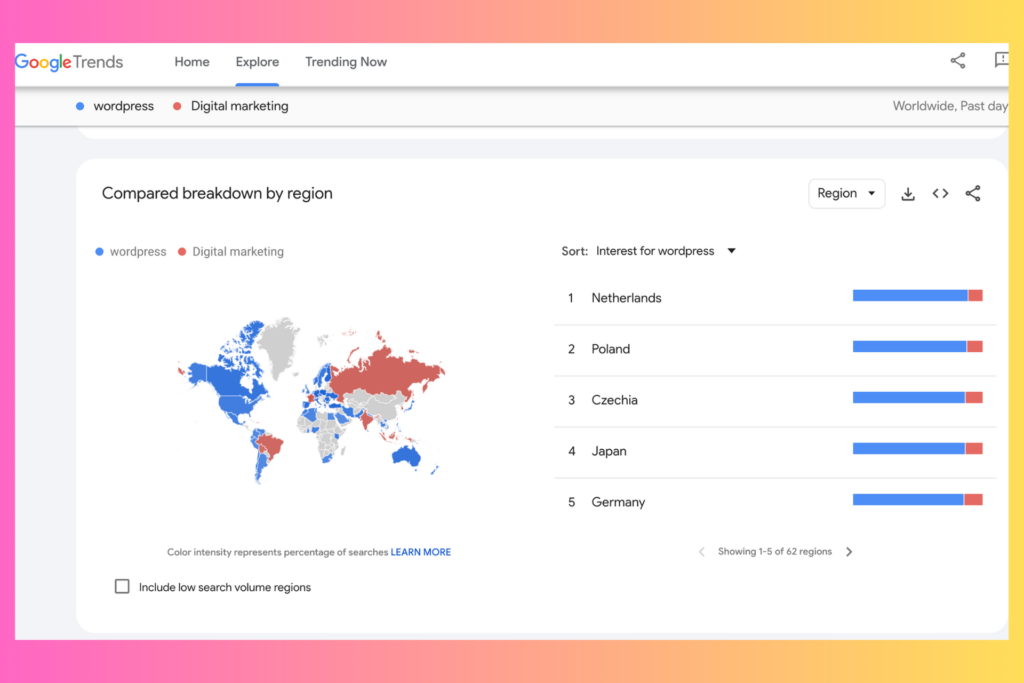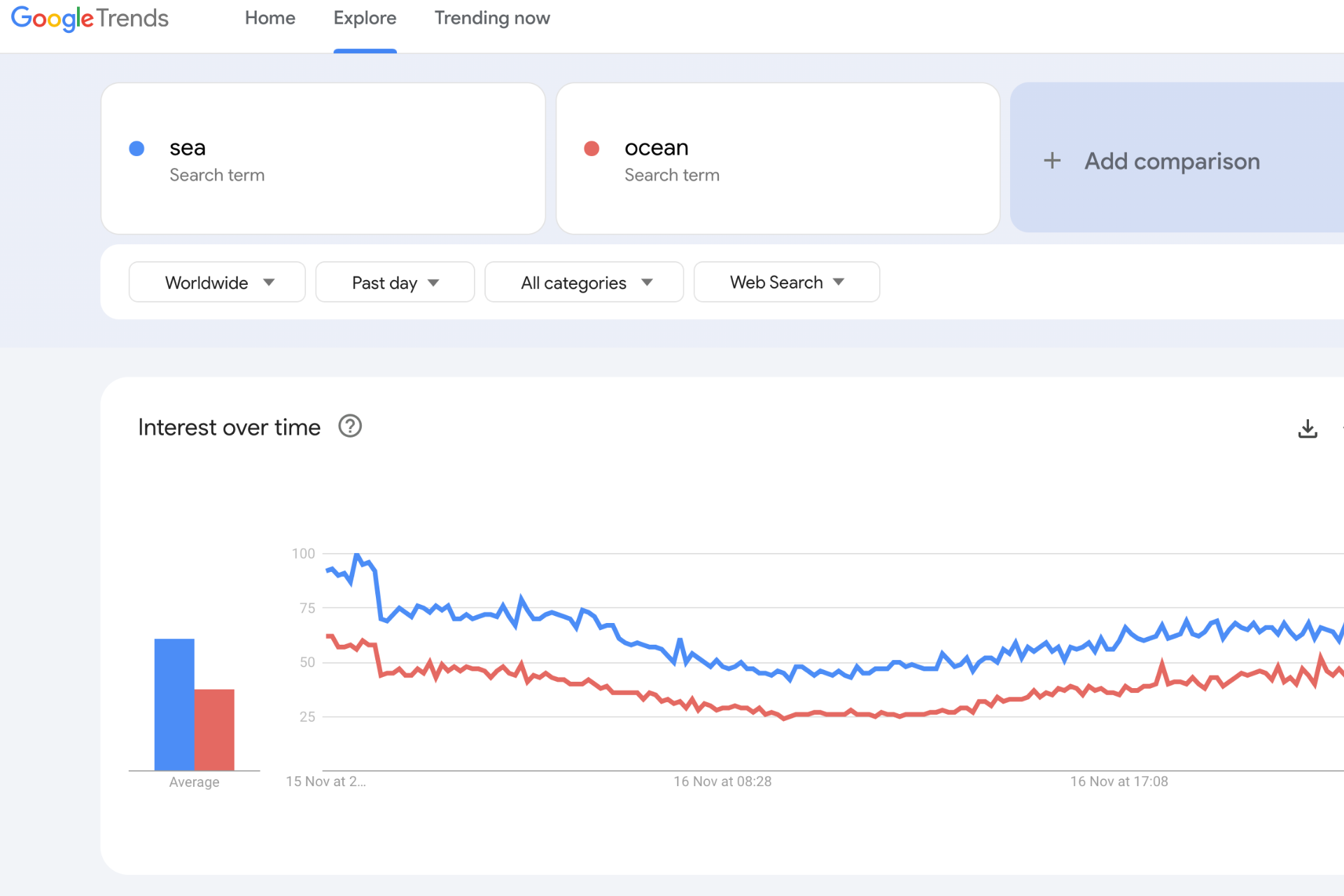Choosing the right keyword search tool is essential for any SEO campaign. However, with so many different tools on the market, it can be hard to know which ones are the best. In this blog post, we will introduce you to one of the most overlooked keyword search tool, and explain why it should be a staple of your SEO strategy.
Introducing the best free keyword search tool you aren’t using: Google Trends
Google Trends is a free tool that allows you to see how search terms are trending over time. This information can be incredibly valuable for SEO, as it can help you to identify keywords that are becoming more popular and keywords that are starting to decline in popularity.
Keyword search tool | How to use Google Trends?

You can find out what keyword research is here
To use Google Trends for keyword research, simply enter the keyword you want to track into the search bar. Google Trends will then show you a graph that shows how the search volume for that keyword has changed over time.
In addition to the graph, Google Trends also provides a number of other useful insights, such as:
- Related searches: This section shows you other keywords that are related to your target keyword. These keywords can be useful for expanding your keyword list.
- Topical interest: This section shows you how much interest there is in the topic of your target keyword on a global scale. This information can be helpful for understanding the potential reach of your content.
- Geographic interest: This section shows you where there is the most interest in your target keyword. This information can help target your content to specific geographic regions.
Why Google Trends is a great keyword research tool?
There are a number of reasons why Google Trends is a great keyword search tool, including:
- It’s free: Google Trends is a free tool, which makes it accessible to businesses of all sizes.
- It’s accurate: Google Trends data is based on real-time search data from Google, which means that it is highly accurate and up-to-date.
- It’s comprehensive: Google Trends provides data for a wide range of keywords, including both long-tail and short-tail keywords.
- It’s easy to use: Google Trends is very easy to use, even for beginners.

How to use Google Trends to improve your SEO campaign
Here are a few tips for using Google Trends to improve your SEO campaign:
- Identify trending keywords: Use Google Trends to identify keywords that are becoming more popular. You can then target these keywords in your content and SEO campaigns.
- Identify declining keywords: Use Google Trends to identify keywords that are starting to decline in popularity. You may want to avoid using these keywords in your content and SEO campaigns.
- Identify related keywords: Use Google Trends to find related keywords that you can use to expand your keyword list.
- Target your content to specific geographic regions: Use Google Trends to see where there is the most interest in your target keyword. You can then target your content to these geographic regions.

Decoding the Future of Google Trends
1. Personalized Searches: Tailored Content for Every User
The future of Google Trends lies in its ability to provide personalized search results, catering to the unique interests and preferences of each individual user. By leveraging machine learning algorithms and user data, Google Trends can anticipate and deliver relevant content, ensuring that users receive the information they need when they need it, in the format that suits them best.
2. Voice Search Revolution: A Shift in the Way We Interact
Voice search fueled by the growing popularity of smart speakers and voice assistants, is poised to revolutionize the way we interact with Google Trends. Voice-based queries will allow for more natural and intuitive interactions, making it easier for users to access the information they seek.
3. Augmented Reality Integration: A Multisensory Experience
Augmented reality (AR) holds immense potential for enhancing the user experience with Google Trends. By overlaying virtual information onto the real world, AR can provide users with a more immersive and interactive way to explore trending topics and events.
4. Immersive Storytelling: Engaging Narratives for a Captivating Experience
Google Trends can move beyond mere data visualization and embrace immersive storytelling, using interactive narratives and multimedia elements to captivate users and bring trending topics to life in a more engaging and memorable manner.
5. Social Media Integration: A Connected and Unified Experience
Google Trends can further enhance its relevance by seamlessly integrating with social media platforms. By connecting trending search data with user-generated content on social media, Google Trends can provide a more holistic and up-to-date view of public sentiment and trends.
6. Predictive Analytics: Forecasting Future Trends with Precision
With the power of machine learning and artificial intelligence, Google Trends can evolve into a powerful predictor of future trends. By analyzing historical search data and current trends, Google Trends can anticipate emerging topics and behaviors, helping businesses, marketers, and individuals make informed decisions.
7. Cross-Platform Consistency: A Unified Experience Across Devices
Google Trends must ensure a consistent and seamless user experience across all devices, from desktop computers to mobile phones and smart speakers. This cross-platform consistency will enable users to access and interact with trending information seamlessly from anywhere, anytime.
8. Ethical Considerations: Balancing Data Privacy with Informed Insights
As Google Trends becomes increasingly sophisticated, it is crucial to address the ethical implications of collecting and analyzing vast amounts of user data. Google must strike a balance between protecting user privacy and providing valuable insights without compromising individual rights.
9. Responsible Innovation: Prioritizing User Trust and Transparency
Google Trends must prioritize user trust and transparency throughout its development and evolution. By clearly defining its data collection practices, explaining its algorithms, and ensuring user control over their data, Google can maintain a reputation for responsible innovation.
10. Community Engagement: Collaborating with Users to Shape the Future
Google Trends should foster a sense of community engagement, inviting users to participate in shaping the future of the tool. By incorporating user feedback and suggestions, Google can ensure that Google Trends remains relevant and responsive to the needs of its users.
Conclusion
Google Trends is a powerful keyword search tool that can help you improve your SEO campaign. It’s free, accurate, comprehensive, and easy to use. If you’re not already using Google Trends for keyword research, we highly recommend that you start.
Featured resources:
The Ultimate Guide What Is SEO and How It Works in 2024?
How do SERP position tools work?
Here are a few additional Semharbor’s tips for using Google Trends effectively:
- Use the “Compare” feature to compare multiple keywords. This can be helpful for identifying which keywords are more popular, and which keywords have a higher search volume.
- Use the “Time range” feature to filter the data by date range. This can be helpful for identifying trends over time.
- Use the “Category” feature to filter the data by category. This can be helpful for finding keywords that are relevant to your industry or niche.
By following these tips, you can use Google Trends to find the best keywords for your SEO campaign and improve your website’s visibility in search engines.



